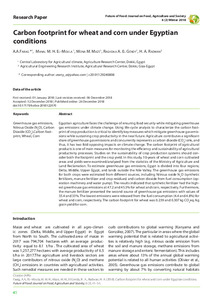Carbon footprint for wheat and corn under Egyptian condition
| dc.date.accessioned | 2019-01-25T16:40:22Z | |
| dc.date.available | 2019-01-25T16:40:22Z | |
| dc.date.issued | 2018-12-26 | |
| dc.identifier | doi:10.17170/kobra-2018122070 | |
| dc.identifier.uri | http://hdl.handle.net/123456789/11038 | |
| dc.language.iso | eng | |
| dc.publisher | Section Specialized Partnerships in Sustainable Food Systems and Food Sovereignty at the University of Kassel, Germany and Federation of German Scientists (VDW) | |
| dc.rights | Urheberrechtlich geschützt | |
| dc.rights.uri | https://rightsstatements.org/page/InC/1.0/ | |
| dc.subject | Greenhouse gas emissions | eng |
| dc.subject | Nitrous Oxide (N2O) | eng |
| dc.subject | Carbon Dioxide (CO2) | eng |
| dc.subject | Carbon footprint | eng |
| dc.subject | Wheat | eng |
| dc.subject | Corn | eng |
| dc.subject.ddc | 630 | |
| dc.title | Carbon footprint for wheat and corn under Egyptian condition | eng |
| dc.type | Aufsatz | |
| dcterms.abstract | Egypt agriculture is facing a great joint challenge of ensuring food security and mitigating greenhouse gas emissions under climate change. Characterizing the carbon footprints of crop production by life cycle analysis is be critical for identifying the key measures to mitigate greenhouse gas emission while sustaining crop productivity in the near future. Agriculture contributes a significant share of greenhouse gas emissions and concurrently represents a carbon dioxide (CO2) sink; it thus has two fold opposing impacts on climate change. The carbon footprint of agricultural products is one of main measures for monitoring the efficiency and sustainability of agricultural productivity processes. Studies on the sustainability of crop production systems should consider both the footprint and the crop yield. In this study, 10-years of wheat and corn cultivated area and yield were used from the statistics of the Ministry of Agriculture and Land Reclamation. Egypt is divided into four regions; Delta, Middle, and Upper Egypt and lands outside the Nile Valley to estimate greenhouse gas emission. The greenhouse gas emission estimated from different sources Nitrous oxide N2O (synthetic fertilizers, manure fertilizer and crop residues) and carbon dioxide from fuel consumption (operation machinery and water pump) for both crops wheat and corn. The results indicated that synthetic fertilizer had the highest greenhouse gas emission 47.2 and 45.5% for wheat and corn, respectively. The manure fertilizer presented the second source of greenhouse gas emission 35.4 and 33% for wheat and corn. The lowest emissions were released from the fuel consumption (4.4 and 4.8%) for wheat and corn, respectively. The carbon footprint for wheat was 0.239 and 0.307 kg CO2eq /kg grain yield for corn. | eng |
| dcterms.accessRights | open access | |
| dcterms.creator | Farag, Ahmed Awny | |
| dcterms.creator | El-Moula, Manal M. H. | |
| dcterms.creator | Maze, Mona M. | |
| dcterms.creator | El Gendy, Raghdaa A. | |
| dcterms.creator | Radwan, Hanafi A. | |
| dc.type.version | publishedVersion | |
| dcterms.source.identifier | 2197-411X | |
| dcterms.source.issue | No. 2 | |
| dcterms.source.journal | Future of Food: Journal on Food, Agriculture and Society | |
| dcterms.source.pageinfo | 41-54 | |
| dcterms.source.volume | Vol. 6 |

